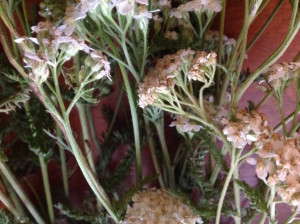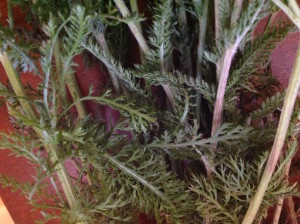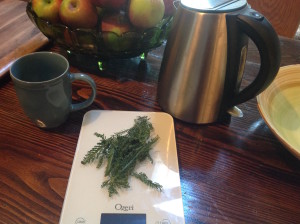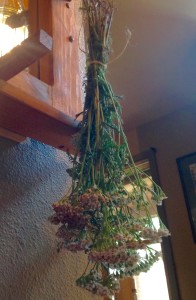You’re in a remote campsite and one of your kids cuts their hand on a pocket knife, the wound doesn’t look too deep but the bleeding just won’t stop. What do you do? Allergy season has hit, dry air and dry nostrils have caused your nosebleeds to flare up and, at times, they are difficult to stop. Understanding your situation, what caused it, possible remedies, and their preparations become more important the further you are from medical help.
In these situations, simply having one herb on hand can help reduce the stress involved in a bleeding situation. Yarrow – one of the most prolific plants in N. America can be found on roadsides, in meadows, along sidewalks, waste areas, and even lawns. As a matter of fact, at one point when I was walking in a small town just west of Salem, Oregon a few weeks ago, I was literally walking through a field of yarrow! Once you know how to identify it, you will see it everywhere, and fortunately it is easily identifiable by its “fe rnlike” or “feather like” leaves that grow alternately down a firm, erect stem and are topped with delicate white flowers (they can sometimes be lilac).
rnlike” or “feather like” leaves that grow alternately down a firm, erect stem and are topped with delicate white flowers (they can sometimes be lilac).
One of the easiest ways to use yarrow is to simply pull a few leaves off of the plant and press them onto the wound or wad them up into a ball and insert into the nostril. This application requires that you can find yarrow near where you are. Alternatively you can dry and powder the plant for carrying in an herbal first aid kit which makes it simpler to transport when camping or hiking as well as keeping on hand in your home.
 This useful herb not only helps stop the flow of blood but can also help speed the healing of wounds which is why it’s important to ensure the wound is clean before application. It also contains both antiseptic and antibacterial properties.
This useful herb not only helps stop the flow of blood but can also help speed the healing of wounds which is why it’s important to ensure the wound is clean before application. It also contains both antiseptic and antibacterial properties.
Here are two Preparations:
Apply a compress to help treat hemorrhoids, rashes, and skin ulcers. Start by making an infusion, dip a clean cloth in the infusion and apply to affected area.
Yarrow Infusion
1 ounce fresh yarrow leaf roughly chopped (1/4 ounce, if dried)
1 cup water (non-chlorinated) brought to just below the boiling point
- Pour hot water over yarrow in cup, bowl, or teapot
- Cover and steep 15 minutes
- Strain well
Use to make a compress (you may also drink this tea up to three times a day but do a little more research to see internal uses). The prepared tea can be stored in an airtight jar for two days in the refrigerator. Feel free to double or half the recipe as needed.
- Dry flower and leaves (you can dry the stems but you won’t be using them) thoroughly. You can either use a dehydrator on herb setting or hang it up to dry. I like the way they look so I prefer to hang them to dry.
- Grind dried flowers and leaves with mortal and pestle into a powder or you can use an herb grinder.
- Store in an air tight jar in a dark, cool place.
Apply the powdered herb directly to the wound.
There are other internal uses of yarrow which I encourage you to investigate (fever reduction, treating colds and flus in the early stages, etc). But, in my opinion, the biggest benefit of gathering and storing yarrow is its usefulness for stopping bleeding and speeding up the healing of an injury. This is definitely an herb I recommend to keep in your Emergency First Aid Kit.
If you are pregnant or nursing, or have allergies to ragweed, please do not take it internally.
*This is NOT medical advice; this is for educational purposes only. You should always check with your doctor before trying any of these remedies.







Leave a Reply
You must be logged in to post a comment.